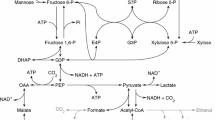Abstract
Anaerobiospirillum succiniciproducens grew on a minimal salts medium containing wood hydrolysate (equivalent to 27 g glucose l−1) and, when supplemented with 10 g corn steep liquor l−1 as a complex nitrogen source, succinic acid at 24 g l−1 was obtained (yield = 88% w/w glucose). This may therefore be an economical method to produce succinic acid.
Similar content being viewed by others
References
Hong YK, Hong WH, Chang YK (2001) Effect of pH on the extraction characteristics of succinic and formic acids with tri-noctylamine dissolved in 1-octanol. Biotechnol. Bioprocess Eng. 6: 347–351.
Kwon S, Lee PC, Lee EG, Chang YK Chang HN (2000) Production of lactic acid by Lactobacillus rhamnosus with vitaminsupplemented soybean hydrolysate. Enzyme Microb. Technol. 26: 209–215.
Landucci R, Goodman B, Wyman C (1994) Methology for evaluating the economics of biologically producing chemicals and materials from alternative feedstocks. Appl. Biochem. Biotechnol. 45–46: 678–696.
Lawford HG, Rousseau JD (1996) Studies on nutrient requirements and cost-effective supplements for ethanol production by recombinant E. coli. Appl. Biochem. Biotechnol. 57–58: 307–326.
Lee PC, Lee WG, Kwon S, Lee SY, Chang HN (1999a) Succinic acid production by Anaerobiospirillum succiniciproducens: effects of the H2/CO2 supply and glucose concentration. Enzyme Microb. Technol. 24: 549–554.
Lee PC, Lee WG, Lee SY, Chang HN (1999b) Effects of medium components on the growth of Anaerobiospirillum succiniciproducens and succinic acid production. Process Biochem. 35: 49–55.
Lee PC, Lee WG, Kwon S, Lee SY, Chang HN (2000a) Batch and continuous fermentation of succinic acid from whey by Anaerobiospirillum succiniciproducens. Appl. Microbiol. Biotechnol. 54: 23–27.
Lee PC, Lee WG, Lee SY, Chang YK, Chang HN (2000b) Fermentative production of succinic acid from glucose and corn steep liquor by Anaerobiospirillum succiniciproducens. Biotechnol. Bioprocess Eng. 5: 379–381.
Lee PC, Lee WG, Lee SY, Chang HN (2001) Succinic acid production with reduced by-product formation in the fermentation of Anaerobiospirillum succiniciproducens using glycerol as a carbon source. Biotechnol. Bioeng. 72: 41–48.
Lee WG, Lee JS, Shin CS, Park SC, Chang HN, Chang YK (1999) Ethanol production using concentrated oak wood hydrolysates and methods to detoxify. Appl. Biochem. Biotechnol. 77–79: 547–559.
Lynd LR, Wyman CE, Gerngross TU (1999) Biocommodity engineering. Biotechnol. Prog. 15: 777–793.
Samuelov NS, Lamed R, Lowe S, Zeikus JG (1991) Influence of CO2-HCO 3+ levels and pH on growth, succinate production and enzyme activities of Anaerobiospirillum succiniciproducens. Appl. Environ. Microbiol. 57: 3013–3019.
Sriram V, Dennis JM (1999) Catalytic upgrading of fermentationderived organic acids. Biotechnol. Prog. 15: 845–854.
Author information
Authors and Affiliations
Corresponding author
Rights and permissions
About this article
Cite this article
Lee, P., Lee, S., Hong, S. et al. Biological conversion of wood hydrolysate to succinic acid by Anaerobiospirillum succiniciproducens . Biotechnology Letters 25, 111–114 (2003). https://doi.org/10.1023/A:1021907116361
Issue Date:
DOI: https://doi.org/10.1023/A:1021907116361




